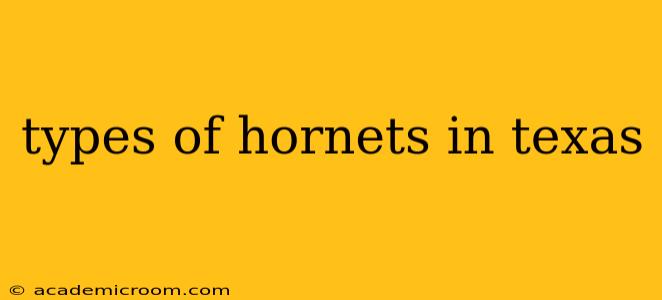Texas, with its diverse ecosystems, is home to several hornet species. Understanding the different types is crucial for safety and effective pest management. This guide will explore the common hornet varieties found in the Lone Star State, detailing their identifying features and behaviors.
What are the different types of hornets in Texas?
While the term "hornet" is often used loosely, true hornets belong to the genus Vespa. In Texas, the most commonly encountered species that fit the general understanding of "hornet" are actually yellowjackets and paper wasps, which are often mistaken for hornets. Let's clarify the distinctions and highlight the species you're most likely to encounter:
1. Bald-faced Hornets (Dolichovespula maculata)
These are true hornets and arguably the most prominent hornet species in Texas. They are easily identifiable by their striking black and white markings, giving them a "bald-faced" appearance. Their nests are large, pear-shaped structures, typically found high in trees or shrubs. Bald-faced hornets are aggressive when their nests are threatened, so maintaining a safe distance is crucial.
2. European Hornets (Vespa crabro)
While less common than bald-faced hornets, European hornets have established themselves in some parts of Texas. They are significantly larger than yellowjackets, with a reddish-brown head and thorax and yellow-banded abdomen. Their nests are usually found in tree hollows or other sheltered locations. Although capable of stinging, they are generally less aggressive than bald-faced hornets unless provoked.
3. Yellow Jackets (Various Species)
Often confused with hornets, yellow jackets are actually a type of wasp. Several species inhabit Texas, exhibiting variations in color and size. They are generally smaller than hornets and are known for their aggressive behavior, particularly during late summer and fall. Their nests can be found underground, in wall voids, or other concealed areas. Yellow jackets are a common nuisance due to their tendency to be attracted to food and drinks.
4. Paper Wasps (Various Species)
Paper wasps, like yellow jackets, are not true hornets but are often mistaken for them. They build open, umbrella-shaped nests, usually attached to eaves, branches, or other sheltered areas. They are generally less aggressive than yellow jackets and hornets, stinging only when threatened directly. Various paper wasp species exhibit different color patterns.
How can I identify a hornet nest?
Hornet nests vary depending on the species. Bald-faced hornets create large, enclosed, pear-shaped nests, while paper wasps build open, umbrella-like structures. Yellow jacket nests are often hidden underground or inside wall cavities. Identifying the nest type can help in determining the species present.
Are hornets in Texas dangerous?
While all hornets and wasps possess stingers, they are generally not aggressive unless provoked. Their stings can be painful, especially for those allergic to their venom. Multiple stings can pose a serious health risk. The best approach is to avoid disturbing nests and maintain a safe distance.
What should I do if I encounter a hornet or its nest?
If you encounter a hornet or its nest, calmly move away from the area. Avoid swatting or making sudden movements. If a nest is located in a dangerous or high-traffic area, consider contacting a pest control professional for removal.
How do I prevent hornets from building nests near my home?
Preventing hornet nests near your home involves sealing potential entry points, removing attractive food sources, and keeping garbage cans tightly covered. Regularly inspect your property for signs of nest construction. Professional pest control services can provide preventative treatments.
This comprehensive guide should help Texans identify the types of hornets and similar stinging insects they might encounter and provide strategies for safe coexistence. Remember, prevention and respectful distance are your best defense against hornet encounters.
